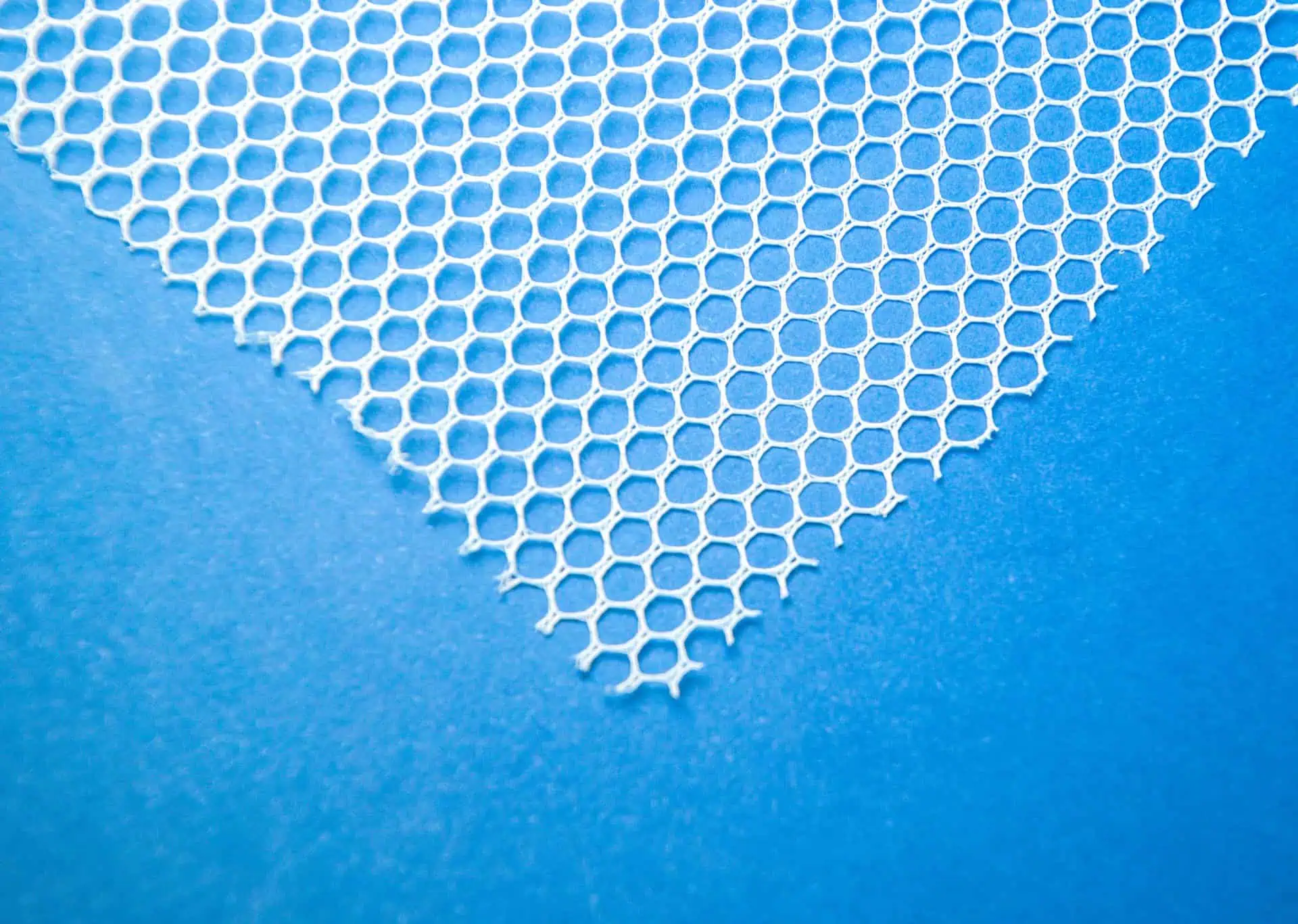Transvaginal Mesh Revision Surgery: What to Expect
- Last Updated: June 12th, 2025

Attorney Jessica Paluch-Hoerman, founder of TruLaw, has over 28 years of experience as a personal injury and mass tort attorney, and previously worked as an international tax attorney at Deloitte. Jessie collaborates with attorneys nationwide — enabling her to share reliable, up-to-date legal information with our readers.
Legally Reviewed
This article has been written and reviewed for legal accuracy and clarity by the team of writers and legal experts at TruLaw and is as accurate as possible. This content should not be taken as legal advice from an attorney. If you would like to learn more about our owner and experienced injury lawyer, Jessie Paluch, you can do so here.
Fact-Checked
TruLaw does everything possible to make sure the information in this article is up to date and accurate. If you need specific legal advice about your case, contact us by using the chat on the bottom of this page. This article should not be taken as advice from an attorney.
Key takeaways:
- Transvaginal mesh revision surgery aims to address complications like mesh erosion, infection, pain, and recurrence of pelvic floor disorders that can significantly impact a patient's quality of life.
- The complications of mesh removal procedures, the potential inability to completely remove the mesh, and persistent issues after surgery pose significant challenges for patients and surgeons.
- Non-surgical alternatives such as antibiotics, creams, and physical therapy techniques may be considered to manage symptoms and improve quality of life without additional surgery.
Overview of Transvaginal Mesh Revision Surgery
On this page, we’ll discuss Transvaginal Mesh Revision Surgery, various reasons for mesh removal or revision, the risks and complications associated with mesh revision surgery, and much more.
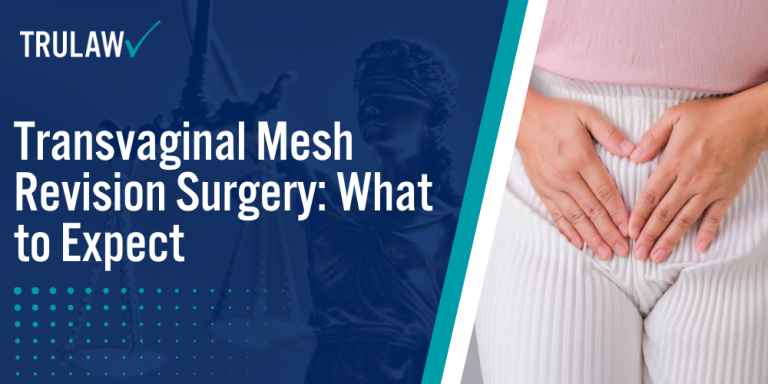
Intro to Transvaginal Mesh Revision Surgery
Some of the key aspects of transvaginal mesh revision surgery include, but are not limited to:
- Indications for Revision: Revision surgery may be necessary to address complications such as mesh erosion, infection, or chronic pain.
- Surgical Techniques: Revision surgery can involve partial or complete removal of the mesh and repair of damaged tissue.
- Challenges and Risks: Mesh revision surgery can be complex and may carry risks such as bleeding, infection, and recurrence of pelvic floor disorders.
- Recovery and Outcomes: Recovery from revision surgery can be lengthy, and outcomes may vary depending on the extent of the damage and the individual patient.
If you’re experiencing complications from a transvaginal mesh implant and are considering revision surgery, it’s essential to consult with a qualified medical professional and explore your legal options.
Contact Tru Law using the chat on this page for a free case evaluation to learn more about your rights and potential compensation related to transvaginal mesh complications and revision surgery.
Table of Contents
Deciding on Transvaginal Mesh Revision Surgery
When opting for transvaginal mesh revision surgery, patients and healthcare providers must evaluate the severity of complications and the individual circumstances dictating surgical intervention.
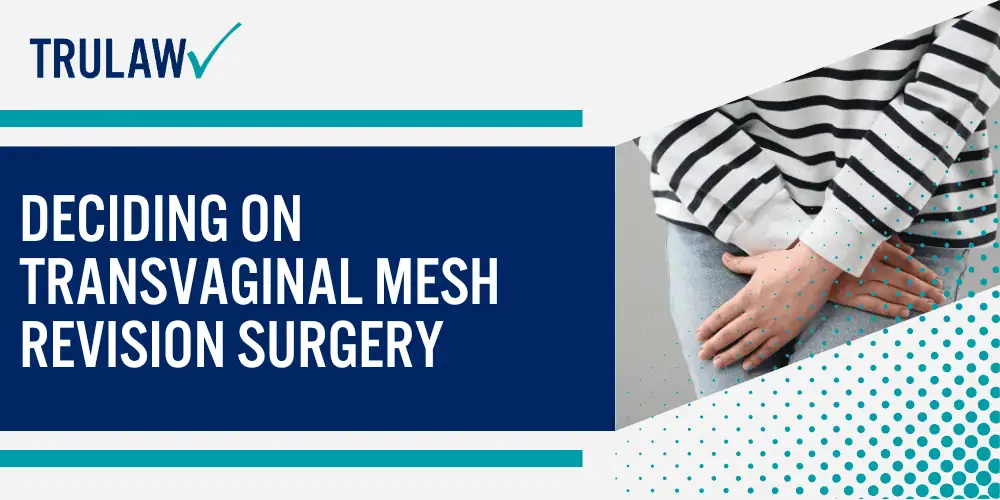
Complications Leading to Transvaginal Mesh Revision
Mesh erosion and pain are often the primary catalysts prompting the consideration of transvaginal mesh surgery.
Surgical mesh, initially used to address pelvic floor disorders, can sometimes lead to serious complications.
Common complications that might necessitate a mesh revision include:
- Vaginal mesh exposure or extrusion into surrounding tissues
- Persistent pain affecting quality of life
- Infection and associated symptoms
- Complications impacting urinary or sexual function
Individual patient experiences may vary, and not all complications require surgical management; some might be managed conservatively.
Factors Determining the Type of Revision Surgery Needed
The approach to surgical management of mesh complications depends on various patient-specific factors and the nature of the complication.
Key determinants for the type of mesh revision surgery include:
- The extent and location of the mesh complication
- The severity of symptoms experienced by the patient
- The presence of any underlying conditions or previous surgeries
- The overall health and surgical risk profile of the patient
A thorough assessment by a healthcare provider is essential to deciding on the appropriate surgical approach.
The aim is to resolve complications while minimizing further risk.
Surgical Options for Transvaginal Mesh Revision
When addressing transvaginal mesh revision, surgeons may opt to trim the eroded mesh or pursue a complete removal, each with unique challenges and considerations.

Trimming Eroded Mesh vs Complete Mesh Removal
Trimming eroded mesh is a less invasive procedure in which only the exposed or problematic part is removed.
Here are the key points:
- Trimming can often alleviate immediate symptoms such as pain or discomfort.
- It is generally a shorter surgery with a quicker recovery time.
- This option can be suitable for patients with minimal exposure and fewer symptoms.
- There is a risk that symptoms may recur, necessitating further intervention.
In contrast, complete mesh removal involves an excision of the entire mesh implantation.
Important aspects include:
- It may be considered for severe mesh-related complications or persistent symptoms.
- Typically, it requires a more extensive surgical approach with longer recovery.
- It can potentially provide a more definitive solution to exposed mesh problems.
- However, it carries a higher risk of complications and may require multiple surgeries.
Risks and Difficulties of Total Mesh Removal Surgery
Performing a total mesh removal poses a significant challenge even for experienced surgeons due to the intricacies of the surgery.
Several factors contribute to this:
- Anatomical Changes: The mesh integrates with the surrounding tissue over time, making it difficult to differentiate and remove.
- Risk of Organ Injury: During mesh extraction, there is an increased risk of damage to nearby organs, such as the bladder or bowel.
- Pain Management: Postoperative pain can be substantial and must be carefully managed.
- Recovery and Outcome: A full recovery might take an extended period, with close follow-up to monitor for potential further vaginal mesh-related issues.
Transvaginal Mesh Revision Surgery Rates and Outcomes
Transvaginal mesh revision has become a focus point for patients and the medical community due to notable fluctuations in surgery rates and variable patient outcomes.

Studies on Transvaginal Mesh Revision Surgery Rates
Mesh surgery is significantly less prevalent now than before regulatory changes.
The Int Urogynecology J has published studies indicating that government regulation has substantially impacted the frequency of these procedures.
This impact is reflected in a documented decrease in mesh use following regulatory changes:
- 29% decrease in mesh use post-regulation
- The shift observed was from the period before to after the latest US Food and Drug Administration (FDA) restrictions
- The trend demonstrated a significant drop immediately after regulation changes
- This change is visualized in the usage data with distinct periods marked by the type of regulatory environment at the time
The utilization rate changed as the medical field responded to concerns over transvaginal mesh complications, reflecting a trend toward more cautious mesh sling use.
Patient Satisfaction After Transvaginal Mesh Removal
Patient satisfaction following mesh revision has been a complicated aspect to quantify.
However, data suggests that removing the mesh can improve postoperative pain outcomes.
Studies examining patient satisfaction after mesh removal surgery suggest:
- Generally positive effect on pain reduction post-revision
- The satisfaction rate is a key factor in determining the success of these procedures
- Mesh-related complications have necessitated revisions for some patients
- A small percentage of cases result in complications such as mesh extrusion
The balance between successful treatment outcomes and patient satisfaction remains a delicate measure for healthcare providers navigating transvaginal mesh interventions.
Challenges of Transvaginal Mesh Revision Surgery
Transvaginal mesh revision surgery poses significant challenges due to the integrated nature of the mesh with surrounding tissues and the potential for long-term pain.
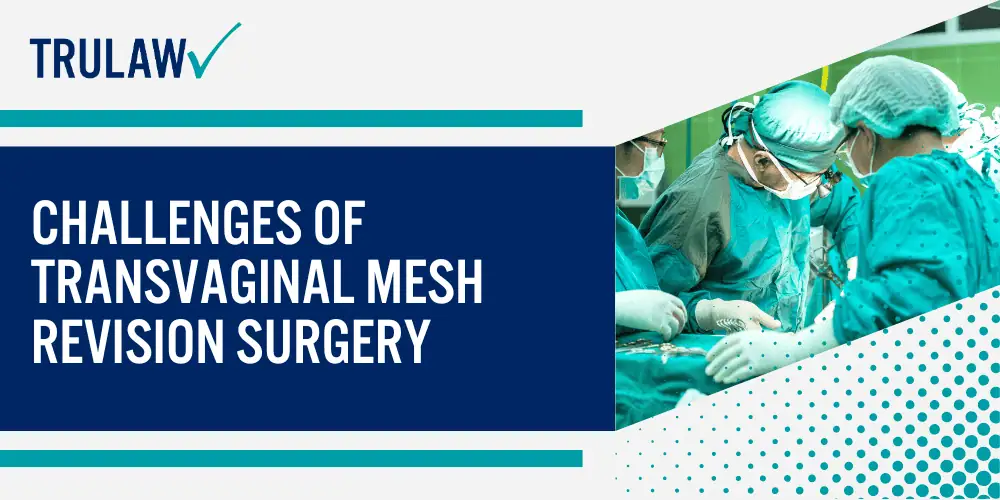
Complexity and Pain of Mesh Removal Procedures
Unlike a standard implant that can be easily removed, the mesh is designed to integrate with the body for long-term repair.
This integration, however, can make removing the mesh a delicate and challenging procedure.
Mesh excision can be particularly difficult due to the mesh’s design to be permanent, leading to the following challenges:
- Vaginal mesh erosion, where the mesh begins to wear away the surrounding tissue, often necessitates careful removal to avoid further damage.
- The intricacy of separating the mesh from tissue can result in prolonged surgery time and the need for specialized surgical skills.
- Chronic pelvic pain may persist or intensify after pelvic floor surgery, complicating the recovery process.
- There is a risk of additional surgical complications, which can require subsequent mesh sling procedures.
Potential Inability to Completely Remove Mesh
While mesh offers reinforcement, it can integrate into the surrounding tissues during healing.
This can make complete removal during a revision surgery challenging.
In cases where mesh revision is needed, complete removal can be impeded by:
- Inevitable scarring and mesh incorporation into the pelvic tissues can make total mesh excision impractical or impossible.
- Residual pain may continue if small mesh pieces remain and irritate surrounding nerves and tissues.
- Individual variations in healing and tissue response can affect the success of removing all mesh material.
- The potential for new complications arising from the attempt to remove embedded mesh, such as organ perforation or bleeding.
Persistent Issues After Transvaginal Mesh Removal
Transvaginal mesh revision is sometimes necessary when complications arise, but removal can lead to persisting problems that affect patient well-being.
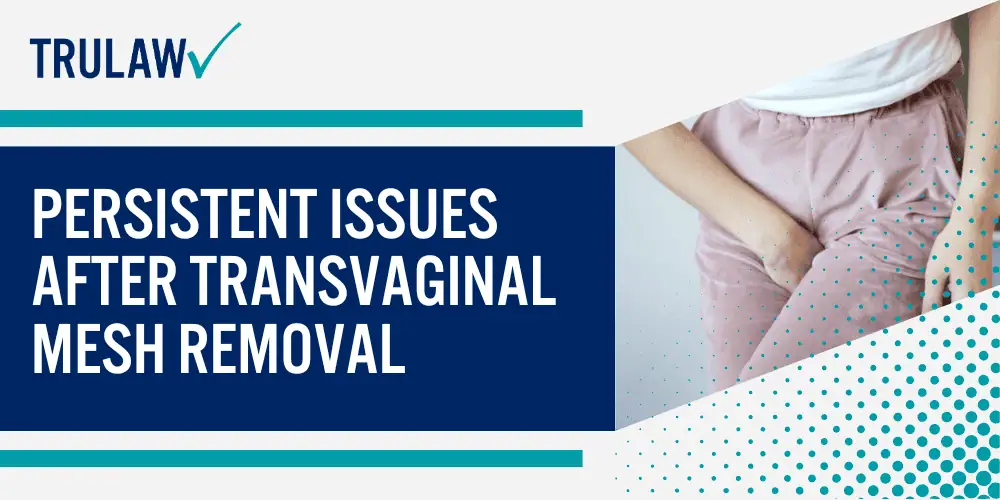
Particular issues may include the recurrence of previous pelvic conditions as well as ongoing inflammatory reactions.
Recurrence of Original Pelvic Floor Disorders
After transvaginal mesh removal, patients might anticipate a potential recurrence of the very disorders they initially sought to correct.
Despite successful pelvic reconstructive surgery, the absence of the mesh doesn’t ensure a complete resolution of pelvic floor disorders.
Here’s a breakdown of some potential recurrences of pelvic floor disorders after mesh removal:
- Persistent Urinary Stress Incontinence: Sometimes, the original stress continence returns, necessitating further management.
- Recurrent Pelvic Organ Prolapse: The risk of organs prolapsing again remains, and additional pelvic floor physical therapy or surgery may be needed.
- Defecatory Dysfunction: Challenges related to bowel movement may reemerge.
- Sexual or Voiding Dysfunction: Discomfort or pain during intercourse may persist or return after mesh removal.
Ongoing Inflammatory Responses After Mesh Excision
Even after mesh extraction, some patients may still experience inflammatory responses indicative of the body’s continued reaction to prior mesh presence.
These inflammatory responses can manifest as:
- Chronic Pain: A common complaint post-surgery, indicative of ongoing inflammation or nerve irritation.
- Infection: Risk may persist where the synthetic mesh is embedded.
- Scar Tissue Formation: This can lead to discomfort or require further intervention.
- Foreign Body Sensation: Some patients report feeling something still in the area where the mesh was removed.
Reconstructive Techniques After Mesh Removal Surgery
Following the surgical removal of vaginal mesh implants, specialized reconstructive techniques are necessary to restore the integrity of the vaginal wall and ensure proper healing.
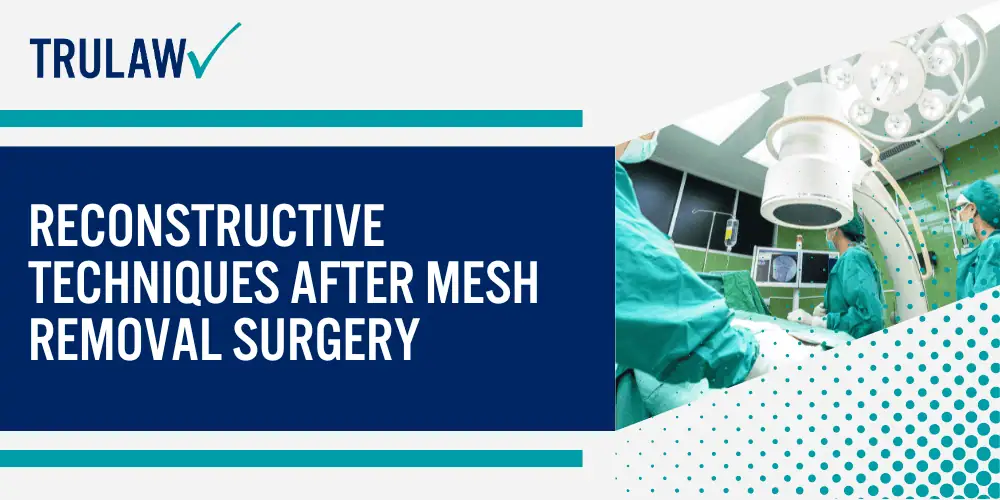
These procedures can significantly vary based on the extent of the damage and the patient’s specific needs, both of which are assessed by a specialist in female pelvic medicine and obstetric gynecol.
Using Grafts or Tissues to Repair Eroded Areas
In the aftermath of mesh removal surgery, surgical treatment may involve using alternative materials to support the pelvic structures.
These materials can include:
- Autologous Grafts: Tissue harvested from the patient’s own body, such as fascia or skin, may be used to repair the vaginal wall.
- Allografts: Cadaveric donor tissue can be used, reducing patient morbidity associated with harvesting autologous tissue.
- Xenografts: Tissue sourced from animals, like porcine or bovine, processed to be suitable for human implantation.
- Synthetic Materials: If natural tissues are not viable or preferred, surgical treatment may revert to using safer, newer synthetic materials designed for better biocompatibility.
Case Study: Omentum Flap Reconstruction After Removal
A case study in omentum flap reconstruction highlights a successful surgical approach after removing the mesh.
To achieve this outcome, the following steps are undertaken:
- Preoperative Evaluation: The pelvic area is carefully assessed to determine the extent of the damage caused by the mesh.
- Surgical Planning: An omentum flap, a richly vascularized layer of fat from the abdomen, is prepared for grafting.
- Reconstruction: The omentum flap is then transposed to the vaginal area, promoting healing and providing structural support.
- Follow-up Care: Regular monitoring and management of any potential complications or infections post-surgery.
By employing these advanced reconstructive techniques, specialists in female pelvic medicine strive to mitigate the consequences of mesh failure and enhance the quality of life for their patients.
Alternatives to Transvaginal Mesh Revision Surgery
For individuals experiencing complications from transvaginal mesh placement, surgery is not the only option available.
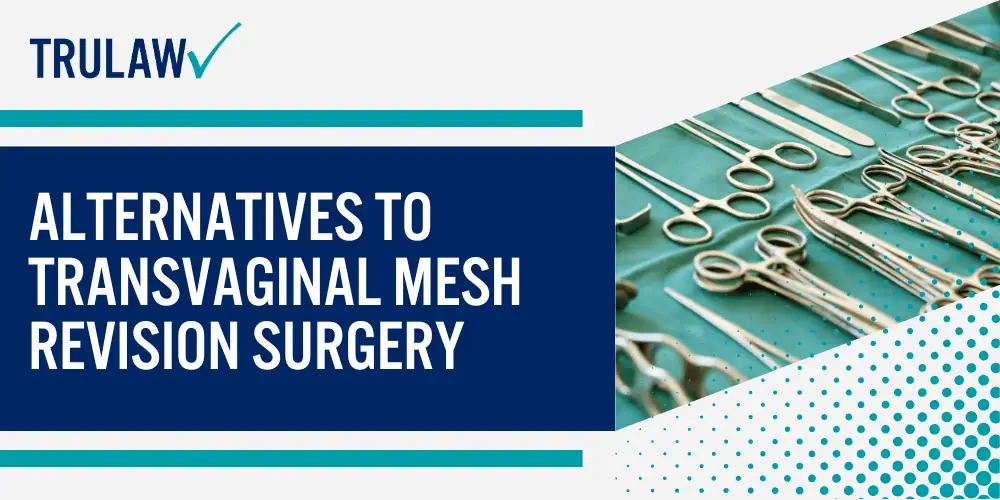
Non-surgical methods can be considered to address discomfort and symptoms affecting the pelvic organs.
Conservative Treatments Like Antibiotics and Creams
Antibiotics and creams may be used when infections or minor irritations arise following mesh placement.
They offer a non-invasive way to manage certain complications:
- Antibiotics can target infections, potentially reducing inflammation and pain.
- Estrogen creams may be applied to help tissue regeneration and support healing.
- Over-the-counter pain relievers might alleviate discomfort.
- Antiseptic solutions can maintain cleanliness and aid in preventing further infections.
Physical therapy techniques reflect a proactive approach to dealing with female urinary incontinence or discomfort resulting from transvaginal mesh placement without additional surgery:
- Specific exercises strengthen the pelvic floor muscles, supporting the pelvic organs.
- Biofeedback, which involves monitoring the body’s functions, can help patients gain better control over their pelvic muscles.
- Techniques like electrical stimulation can be used to improve muscle function.
- Personalized regimens can address individual symptoms, improving quality of life over time.
Transvaginal Mesh Lawsuit Frequently Asked Questions
-
The typical recovery time after transvaginal mesh removal can vary, generally ranging from several weeks to a few months.
Factors such as the complexity of the surgery and the patient’s overall health affect recovery duration.
-
Mesh erosion is typically identified through symptoms such as pain, bleeding, discomfort during intercourse, and urinary problems.
A medical examination, including imaging studies, can confirm the diagnosis.
-
While surgical revision can alleviate some complications arising from transvaginal mesh, it may not resolve all issues.
Success rates can depend on the nature of the complication and the individual’s health condition.
-
Patient experiences with transvaginal mesh revisions are varied; some report significant relief from symptoms, while others may experience ongoing discomfort or require additional procedures.
-
Potential risks of transvaginal mesh removal include infection, damage to surrounding tissues, bleeding, and the possibility of persistent symptoms.
Informed consent is critical before the surgical procedure commencement.
-
The controversy surrounding pelvic mesh implants stems from the significant number of adverse events reported, leading to regulatory scrutiny and resulting in enhanced FDA requirements for the use of these devices.
Concerns focus on the safety and efficacy of the mesh when used to treat pelvic organ prolapse repairs.

Managing Attorney & Owner
With over 25 years of legal experience, Jessica Paluch-Hoerman is an Illinois lawyer, a CPA, and a mother of three. She spent the first decade of her career working as an international tax attorney at Deloitte.
In 2009, Jessie co-founded her own law firm with her husband – which has scaled to over 30 employees since its conception.
In 2016, Jessie founded TruLaw, which allows her to collaborate with attorneys and legal experts across the United States on a daily basis. This hypervaluable network of experts is what enables her to share the most reliable, accurate, and up-to-date legal information with our readers!
Additional Transvaginal Mesh Lawsuit resources on our website:
Here, at TruLaw, we’re committed to helping victims get the justice they deserve.
Alongside our partner law firms, we have successfully collected over $3 Billion in verdicts and settlements on behalf of injured individuals.
Would you like our help?
At TruLaw, we fiercely combat corporations that endanger individuals’ well-being. If you’ve suffered injuries and believe these well-funded entities should be held accountable, we’re here for you.
With TruLaw, you gain access to successful and seasoned lawyers who maximize your chances of success. Our lawyers invest in you—they do not receive a dime until your lawsuit reaches a successful resolution!
AFFF Lawsuit claims are being filed against manufacturers of aqueous film-forming foam (AFFF), commonly used in firefighting.
Claims allege that companies such as 3M, DuPont, and Tyco Fire Products failed to adequately warn users about the potential dangers of AFFF exposure — including increased risks of various cancers and diseases.
Depo Provera Lawsuit claims are being filed by individuals who allege they developed meningioma (a type of brain tumor) after receiving Depo-Provera birth control injections.
A 2024 study found that women using Depo-Provera for at least 1 year are five times more likely to develop meningioma brain tumors compared to those not using the drug.
Suboxone Tooth Decay Lawsuit claims are being filed against Indivior, the manufacturer of Suboxone, a medication used to treat opioid addiction.
Claims allege that Indivior failed to adequately warn users about the potential dangers of severe tooth decay and dental injuries associated with Suboxone’s sublingual film version.
Social Media Harm Lawsuits are being filed against social media companies for allegedly causing mental health issues in children and teens.
Claims allege that companies like Meta, Google, ByteDance, and Snap designed addictive platforms that led to anxiety, depression, and other mental health issues without adequately warning users or parents.
Transvaginal Mesh Lawsuits are being filed against manufacturers of transvaginal mesh products used to treat pelvic organ prolapse (POP) and stress urinary incontinence (SUI).
Claims allege that companies like Ethicon, C.R. Bard, and Boston Scientific failed to adequately warn about potential dangers — including erosion, pain, and infection.
Bair Hugger Warming Blanket Lawsuits involve claims against 3M — alleging their surgical warming blankets caused severe infections and complications (particularly in hip and knee replacement surgeries).
Plaintiffs claim 3M failed to warn about potential risks — despite knowing about increased risk of deep joint infections since 2011.
Baby Formula NEC Lawsuit claims are being filed against manufacturers of cow’s milk-based baby formula products.
Claims allege that companies like Abbott Laboratories (Similac) and Mead Johnson & Company (Enfamil) failed to warn about the increased risk of necrotizing enterocolitis (NEC) in premature infants.
Here, at TruLaw, we’re committed to helping victims get the justice they deserve.
Alongside our partner law firms, we have successfully collected over $3 Billion in verdicts and settlements on behalf of injured individuals.
Would you like our help?
